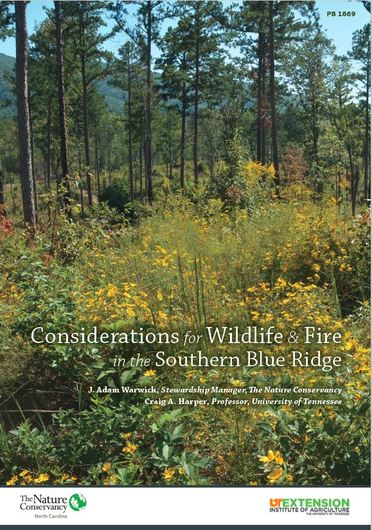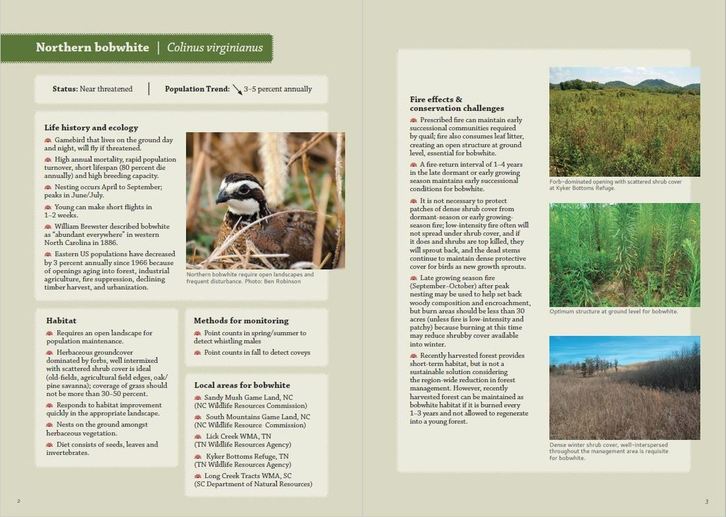
Decades of fire suppression have created dense forests throughout the southern Blue Ridge, significantly altering native plants and the wildlife that depend on them.
Populations of several wildlife species once common in the southern Blue Ridge have plummeted because of fire suppression and a lack of forest management. A decline in the bee population, which has dropped by 50 percent across the world in the past 120 years, could be at least partially the result of the changed forest structure. Greater numbers of bees are found in mature, open forest with little shrub cover, which is maintained by frequent fire. The grasses and other plants that follow fire provide habitat for many more insects that are critical food for young quail and turkey.
Many people don’t realize that fire plays a crucial role in maintaining forest health and that it is important for the animals that live in the forest. A new publication, “Considerations for Wildlife and Fire in the Southern Blue Ridge.” authored by Adam Warwick of The Nature Conservancy and Craig Harper, professor of wildlife management at the University of Tennessee, highlights effects of controlled burning on wildlife.
“A land manager’s time is pulled in many directions, and it’s hard to comb through hundreds of scientific papers to figure out how controlled burning can improve habitat for a particular animal,” says Warwick. “Fire is critical to maintain habitat for many species, but you want to make sure you are using fire in the right places at the right time to improve plant and animal health.”
“It is inarguable that fire was historically prevalent and highly influential on plant and animal communities in the southern Appalachians, especially on exposed southern and western aspects,” says Craig Harper. “However, one size does not fit all with regard to fire and wildlife. We hope this publication will provide information that will help land managers use fire in a constructive manner for various wildlife and plant communities in the region.”
“We now have a document that combines more than 60 years of research with the experiences of highly respected land managers from this area. The information is presented in a way that is easy to read and reference” says Warwick. “We hope public and private landowners gain an understanding of the importance of fire to wildlife.”
The publication was funded by the University of Tennessee Institute of Agriculture and the Southern Blue Ridge Fire Learning Network, a partnership of government, conservation groups, and individuals working to return fire to the mountains. Those interested in obtaining a limited number of free hard copies can email j lamb AT tnc DOT org (please allow 3-4 weeks to receive) or order online via the University of Tennessee Institute for Agriculture at https://goo.gl/aTyf5g. A digital copy is available for download here.
Populations of several wildlife species once common in the southern Blue Ridge have plummeted because of fire suppression and a lack of forest management. A decline in the bee population, which has dropped by 50 percent across the world in the past 120 years, could be at least partially the result of the changed forest structure. Greater numbers of bees are found in mature, open forest with little shrub cover, which is maintained by frequent fire. The grasses and other plants that follow fire provide habitat for many more insects that are critical food for young quail and turkey.
Many people don’t realize that fire plays a crucial role in maintaining forest health and that it is important for the animals that live in the forest. A new publication, “Considerations for Wildlife and Fire in the Southern Blue Ridge.” authored by Adam Warwick of The Nature Conservancy and Craig Harper, professor of wildlife management at the University of Tennessee, highlights effects of controlled burning on wildlife.
“A land manager’s time is pulled in many directions, and it’s hard to comb through hundreds of scientific papers to figure out how controlled burning can improve habitat for a particular animal,” says Warwick. “Fire is critical to maintain habitat for many species, but you want to make sure you are using fire in the right places at the right time to improve plant and animal health.”
“It is inarguable that fire was historically prevalent and highly influential on plant and animal communities in the southern Appalachians, especially on exposed southern and western aspects,” says Craig Harper. “However, one size does not fit all with regard to fire and wildlife. We hope this publication will provide information that will help land managers use fire in a constructive manner for various wildlife and plant communities in the region.”
“We now have a document that combines more than 60 years of research with the experiences of highly respected land managers from this area. The information is presented in a way that is easy to read and reference” says Warwick. “We hope public and private landowners gain an understanding of the importance of fire to wildlife.”
The publication was funded by the University of Tennessee Institute of Agriculture and the Southern Blue Ridge Fire Learning Network, a partnership of government, conservation groups, and individuals working to return fire to the mountains. Those interested in obtaining a limited number of free hard copies can email j lamb AT tnc DOT org (please allow 3-4 weeks to receive) or order online via the University of Tennessee Institute for Agriculture at https://goo.gl/aTyf5g. A digital copy is available for download here.
Species included are:
Northern bobwhite
Golden-winged warbler
Wild turkey
Ruffed grouse
American Woodcock
Indiana bat
Eastern and Appalachian cottontail
White-tailed deer
Eastern and Appalachian spotted skunk
Timber rattlesnake
Plethodontid salamanders
Bees
Butterflies and moths
